Share
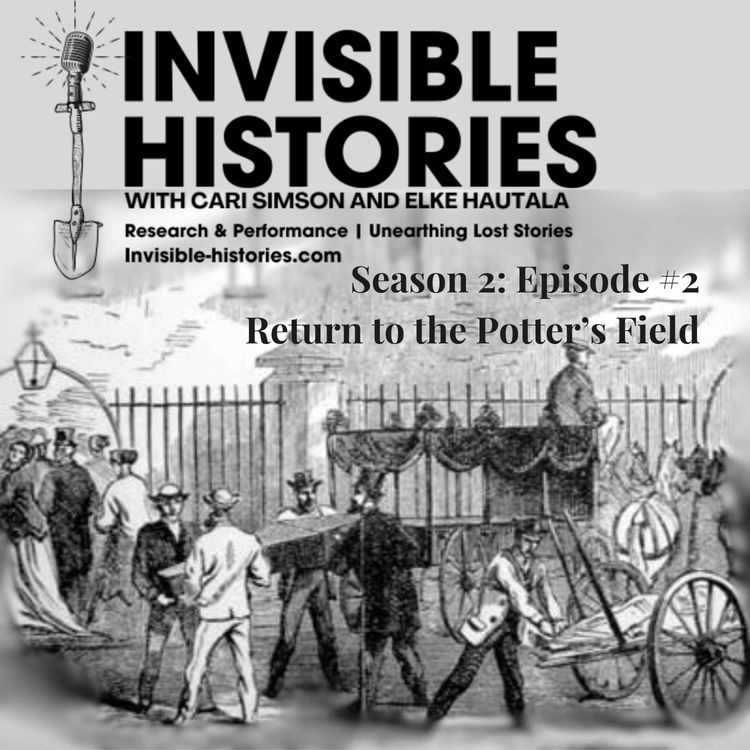
Invisible Histories
A Return to the Potter's Field
Welcome to Invisible Histories!
Tonight we bring you a special show like no other. If you've listened to the first three episodes -- and if not go back to Episode #1 -- we come to this podcast with a deep curiosity about the people who lived in this time period, how they died, and how they ended up being buried in the Potter’s Field between 1876-1912.
Elke and I wanted to transport you to where the Potter’s Field used to be, on a windy point of land in what is known today as the neighborhood of Georgetown in Seattle, WA.
We took a little field trip to 500 South Myrtle Street, deep in the side streets of Georgetown’s industrial area. We thought maybe by visiting in person, on a quiet full moon night, we perhaps could feel something there, and get some answers? ...We were definitely not trying to open a portal …..!
Listen now to hear the spirits of Madame Victoria, Coroner Charles E. Hoye, Thomas Hamilton Blanck, Mary Dugan, Millie Schiller, Lewis Jones, Fred Boalt, Joseph Miller, and Effie Lassen.
Please subscribe and keep listening wherever you get your podcasts!
We are always looking for “invisible histories” of the Pacific NW so if you have a good story idea please reach out at invisiblehistoriespnw@gmail.com -
Check out our landing page at www.invisible-histories.com
Our Instagram account will share images from each episode, @invisiblehistoriespnw
Show Notes:
HistoryLink page about the Potter's Field
The Meadows, Seattle's first great racetrack
"No Rest for The Unwept Dead" The Seattle Times, June 15, 1904, p. 9
Credits:
Sound FX from FreeSound.org
Including USC Cinema Archival Sound FX from 1930s-1960s (Craig Smith)
Juskiddink_waves-caves2
Bennstir_door-slam-1
Yin_Yang_Jake007_water-splash
Theknave_coins-into-tin-cup-2
Cueckermann_womans-harmonics-gasps
AlesiaDavina_a-sirens-song
Timbre_stretched-theremin-01
zabuhailo__hippodromewarm-up-horses
aarrnnoo__woman-crying
martina_leitschuh__people_laughing_outdoors_002
robertcrosley__elbow-river-rivulet-220602-t020
Music from FreeSound.org 1906 Marvel Player Piano from San Francisco
rtb45__mm-project-3-old-marvel-player-piano
Characters played by Elke Hautala, Clayton Ballard, Brian Dougherty, Patti Amundson, Sarah Sherman, Pat Dolan, and Andy Bookwalter.
Interviews by Cari Simson. Based on actual historical research with touches of speculative fiction here and there!
Recorded at Works Progress Cooperative in Seattle WA - Seattle’s only cooperatively run coworking space - www.worksprogress.coop
Audio edited by Elke Hautala
April 2024
Cari Simson and Elke Hautala formed Invisible Histories to visually and viscerally connect the public to experiences from the past. Their Invisible Histories podcast unearths diverse local stories and forgotten places. www.invisible-histories.com
More episodes
View all episodes
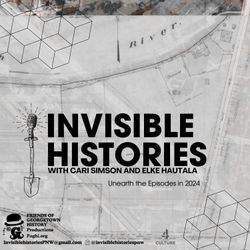
Introducing "Invisible Histories"
03:00||Season 1, Ep. 0Welcome to “Invisible Histories” exploring Seattle’s lost stories. In this podcast we explore lost stories of marginalized people, hidden histories of forgotten places, and generally unearth some cool, creepy and hopefully meaningful connections for people living and working in the Seattle area and beyond. In our first series we explore the ‘lost’ Potter’s Field, a cemetery established in 1876 on land next to the King County Poor Farm and Hospital in what is now the Georgetown neighborhood. In just over 30 years over 3,260 people were buried there; people who due to lack of money, family or other connections had nowhere else to go when they died. In 1912 the Army Corps of Engineers embarked on the ambitious “Duwamish Canal,” turning the river’s meandering curves into a 5-mile shipping channel and turning “useless mudflats” into industrial land. The Duwamish Cemetery aka “Potter’s Field” was erased from maps and memories, covered with industrial businesses and all 3260 human remains were exhumed and cremated. Find out about who was buried there and what happened to their ashes.Subscribe and keep listening wherever you get your podcasts.Check out our landing pageOur Instagram account will share images from each episode, @invisiblehistoriesPNWWe are always looking for “invisible histories” of the Pacific NW so if you have a good story idea please reach out at invisiblehistoriespnw@gmail.com.Our podcast music is from Samuel Coleridge Taylor's (1875 - 1912) Funeral March, Op. 79 Nº 3 (from Othello, Incidental Music)Recorded at Works Progress Cooperative www.worksprogress.coopEdited by Elke Hautala2023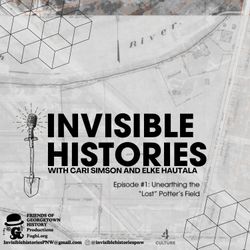
1. Unearthing the "Lost" Potter's Field
43:58||Season 1, Ep. 1Hello -- and welcome to “Invisible Histories” exploring Seattle’s lost stories, with Cari and Elke - Episode #1In this podcast we explore lost stories of marginalized people, hidden histories of forgotten places, and generally unearth some cool, creepy and hopefully meaningful connections for people living and working in the Seattle area and beyond. In our first series we explore the ‘lost’ Potter’s Field, also known as the Duwamish Cemetery established in 1876 on land next to the King County Poor Farm and Hospital in what is now the Georgetown neighborhood. In just over 30 years over 3,260 people were buried there; people who due to lack of money, family or other connections had nowhere else to go when they died. In 1912 the Army Corps of Engineers embarked on the ambitious “Duwamish Canal,” turning the river’s meandering curves into a 5-mile shipping channel and turning “useless mudflats” into industrial land. The Duwamish Cemetery aka “Potter’s Field” was erased from maps and memories, all 3260 human remains were exhumed and cremated, and covered with industrial businesses .In Episode #1 Elke and Cari share their research experiences, and why this story of finding the lost cemetery is connected to many aspects of Seattle's growth and development.Subscribe and keep listening where you get your podcastsRead our latest newsletter!Show notes at Our landing page Our Instagram account will share images from each episode, @invisiblehistoriesPNWWe are always looking for “invisible histories” of the Pacific NW; please reach out at invisiblehistoriespnw@gmail.com.Our podcast music is from Samuel Coleridge Taylor's (1875 - 1912) Funeral March, Op. 79 Nº 3 (from Othello, Incidental Music)Recorded at Works Progress CooperativeEdited by Elke Hautala2023Resources:Friends of Georgetown History: www.foghi.orgHistoryLink article about GeorgetownKing County Archives: https://kingcounty.gov/en/legacy/depts/records-licensing/archives4Culture: https://www.4culture.org/ King5 Evening's coverage of the Potter's Field: https://www.king5.com/article/entertainment/television/programs/evening/seattle-georgetown-cemetery-mystery-missing-bodies-remains-graves/281-4a5f7ebf-c596-4ab8-8c22-54727e5af11fPaul Dorpat - Seattle Waterfront historyhttps://pauldorpat.com/2009/07/09/seattle-waterfront-history-chapter-7/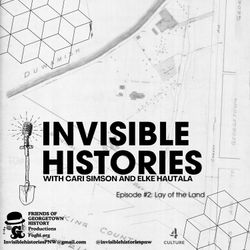
2. Lay of the Land
01:02:50||Season 1, Ep. 2Welcome to Invisible Histories - Episode #2In this podcast we explore lost stories of marginalized people, hidden histories of forgotten places, and generally unearth some cool, creepy and hopefully meaningful connections for people living and working in the Seattle area and beyond. In this episode we go way back in time, to share the perspective of a character that rarely gets to tell its story — the land itself — how the cemetery removal was an example of forced industrialization and this progress at all costs mentality; contextualizing the land in Georgetown, and the existing death and burial practices of the time, as well as how there was an evolution of infrastructure as Seattle became what we like to think of as modern city in the early 1900s.Unearth the history of the land around the Potter’s Field with us and explore a glimpse of the old Seattle. This formerly out-of-the-way place that held the dead from the early days of Washington Territory up through Statehood in 1887, was erased from maps and memories as Seattle entered the Modern era.Featuring Elizabeth Davis PhD and music by Kevin MacLeod in a special introduction.Subscribe and keep listening wherever you get your podcasts.Read our latest newsletter!Check out our landing pageOur Instagram account will share images from each episode, @invisiblehistoriesPNWWe are always looking for “invisible histories” of the Pacific NW so if you have a good story idea please reach out at invisiblehistoriespnw@gmail.com.Our podcast music is from Samuel Coleridge Taylor's (1875 - 1912) Funeral March, Op. 79 Nº 3 (from Othello, Incidental Music)Recorded at Works Progress Cooperative www.worksprogress.coopEdited by Elke Hautala2023Resources:Elizabeth Davis, PhD: https://ess.uw.edu/people/elizabeth-davis/Samuel Coleridge Taylor: (1875 - 1912) Funeral March, Op. 79 Nº 3 (from Othello, Incidental Music) https://en.wikipedia.org/wiki/Samuel_Coleridge-Taylor RH Thompson: https://en.wikipedia.org/wiki/Reginald_H._Thomson The King County Indigent Remains program https://kingcounty.gov/en/dept/dph/health-safety/medical-examiner/indigent-remains-program The King County Medical Examiner's Office unidentified remains. https://kingcounty.gov/en/dept/dph/health-safety/medical-examiner/unidentified-remains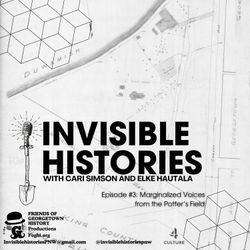
3. Marginalized voices from the Potter's Field
01:03:23||Season 1, Ep. 3Welcome to Invisible Histories. Episode #3In this podcast we explore lost stories of marginalized people, hidden histories of forgotten places, and generally unearth some cool, creepy and hopefully meaningful connections for people living and working in the Seattle area and beyond. In this episode, we share some important cultural information regarding Indigenous death practices of the Coast Salish people, to answer the question, 'could the Potter's Field have previously been an Indian Burial Ground' as described on Findagrave.com? We include interviews from Johnny Moses and Pamela Bond Seamoster who each share the cultural practices of their families.We also explore how someone would end up in the Potter's Field in the early 1900s, and more information about the King County Hospital and Poor Farm, which was also host to a Tuberculosis sanitorium through 1911. We also share the stories of over 10 individuals whose remains were interred at the Duwamish Cemetery, aka the Potter's Field, including Ingo Singh, Mary Lake, James Carter, Thomas Hamilton Blanck, and a sad story of an infant secretly buried by her parents in the dead of night.Subscribe and keep listening wherever you get your podcasts.Read our latest newsletter!Check out our landing pageOur Instagram account will share images from each episode, @invisiblehistoriesPNWWe are always looking for “invisible histories” of the Pacific NW so if you have a good story idea please reach out at invisiblehistoriespnw@gmail.com.Our podcast music is from Samuel Coleridge Taylor's (1875 - 1912) Funeral March, Op. 79 Nº 3 (from Othello, Incidental Music)Recorded at Works Progress Cooperative www.worksprogress.coopEdited by Elke Hautala2023Episode resources:Johnny Moses: https://johnnymoses.com/ Pamela Bond: https://www.4culture.org/touring_arts/pamela-chelalakem-bond-snohomish-2/ Sisters of Providence: https://sistersofprovidence.net/history/ RH Thompson: https://en.wikipedia.org/wiki/Reginald_H._Thomson Asahel Curtis - photo collection: https://www.washingtonhistory.org/research/collections-search/?search_term=&subjects%5B%5D=Asahel%20Curtis Findagrave: https://www.findagrave.com/cemetery/241472/duwamish-poor-farm-cemetery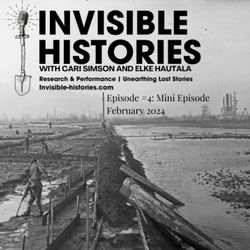
4. Mini Episode February 2024
30:57||Season 1, Ep. 4After a whirlwind January 2024, the Invisible Histories ladies regroup, try to tidy up the place, and catch up on what happened over the last month. Thank you to our listeners, the dedicated hundreds! Subscribe, share, and give us a review wherever you listen to podcasts!Read our latest newsletter and subscribeRead show notes and more content at our webpage.Check out our Instagram for images related to this episode @invisiblehistoriespnwWe toured the Recompose facility in Georgetown, and learned about composting as an option for death care.We visited the Black Heritage Society's archives in Georgetown, and learned about Black Rosie the Riveters at Boeing during WWII, including Josie Dunn, and Florice Spearman who was the first Black stenographer hired by the Boeing Company.Coming up:Friends' of Georgetown History's Georgetown Haunted History Tour, early planning phases, and meeting with returning cast members for October 3-12th 2024Rolland Denny mansion visit - coming soon! www.lochkelden.org David Williams, author of Seattle Walks and Too High Too Steep, walked through Georgetown to include neighborhood highlights in his upcoming book. Future episode about Culturally Modified Trees (CMTs) as mentioned in episode #3 - connecting with representatives of the Duwamish Tribe and Snoqualmie Tribe.History of Seattle neighborhoods of SODO and Harbor Island, and King County's sewer system history - starting research about this important and very hidden history. Music: Junkman Rag by Fred Van Eps, an African American composer/musician.Image: Seattle Municipal Archives: Duwamish Sanitary Fill [workers laying pipe] February 18 1914Recorded at Works Progress CooperativeEdited by Elke HautalaFebruary 2024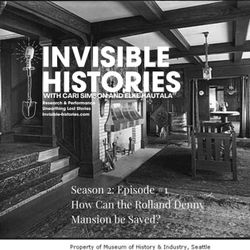
1. How Can the Rolland Denny Mansion be Saved?
01:30:00||Season 2, Ep. 1March 2024 was wild! We suffered technical issues in the form of a broken computer, which prevented us from getting this episode out in a timely manner. Thank goodness we are up and running again!Thank you to our listeners, the dedicated hundreds! Subscribe, share, give us a review wherever you listen to podcasts!Read our latest newsletter and subscribeShow notes and other content at our webpage.Check out our Instagram for images related to this episode.Today, we interviewed Jean Sherrard and Clay Eals, and explored a wide-ranging conversation that includes their work with Paul Dorpat, the “Now and Then” column in the Seattle Times, the pending Rolland Denny Mansion sale, historic preservation, and zooming in on old timey large format photographs. Stay tuned for our theatrical episode about the Potter’s Field - Featuring: Clayton Ballard, Patti Amundson, Pat Dolan, Andy Bookwalter, Brian Dougherty, and Sarah ShermanGet out there and make some history!Show Notes:Rolland Denny mansion: lochkelden.orgSeattle Now & Then column about Rolland Denny MansionRolland Denny Redfin listing (interior pics!): https://redf.in/SRTD5vRolland Denny mansion address: 6601 NE Windermere Rd. Please respect neighbors and the current residents who live there.Please contact info@historicseattle.org to let them know your ideas for how the Rolland Denny mansion could be saved.Paul DorpatSeattle Now & ThenPaul is at 1250 NE 145th St, Shoreline: avamereshoreline.com. Well wishes welcomed!Link to Paul's collection at Seattle Public Library: https://cdm16118.contentdm.oclc.org/digital/collection/p16118coll41The Helix: https://cdm16118.contentdm.oclc.org/digital/collection/p16118coll38Ron Edge's work and expertise on the Paul Dorpat blog.Clay Eals' historic preservation examples: two brief TV news stories from Jan. 29, 1989, featuring Paul when the community first picketed the Admiral Theater’s closing, leading to the landmarking of it that summer.Music: Little Grey Home in the West: 2-10-1916Recorded at Works Progress Cooperative on March 17, 2024Edited by Elke Hautala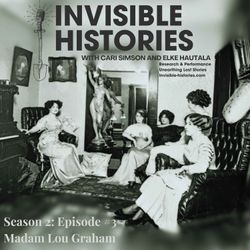
3. Madam Lou Graham
01:12:28||Season 2, Ep. 3Welcome to Invisible Histories.Today we had the pleasure to host a virtual interview with author Hanna Brooks Olsen about her recently published book, “Notoriously Bad Character: the true story of Lou Graham and the Immigrants and Sex Workers who built Seattle." The book is available through her webpage, www.hannabrooksolsen.com Lou reigned supreme in what we now know as the Pioneer Square neighborhood of Seattle in the late 1800s. Today, on Seattle’s Underground Tour and other guided history walks, the story of Lou Graham is often full of errors and exaggerations, and so we are grateful for Hanna’s research to bring the true stories of Lou to light, and inspire other researchers to try and find out more. So grab your favorite beverage, sink into your comfy chaise lounge and transport yourself to when the mysterious German immigrant Dorothea Ohben had just arrived in Seattle.Show Notes:LGBTQIA+ Archives: https://archive.lgbt/wiki/index.php/Madame_Louise_%22Lou%22_Graham_(1861-1903)Hanna Brooks Olsen's webpage: hannabrooksolsen.comHanna's research for HistoryLink Tours: HistoryLink Tours — Union Gospel Mission/Former location of Lou Graham’sHanna's Seattle Met article: https://www.seattlemet.com/news-and-city-life/2022/08/lou-graham-brothel-madam-seattle-history-underground-tour Madam Lou Graham arrives in Seattle in February 1888: https://www.historylink.org/File/2762Image: Purported sex workers, Seattle ca. 1900, courtesy of Paul Dorpat.Music: Music from Library of Congress: Wohlauf noch getrunken (To Wake Up Still Drunk) 1904 https://www.loc.gov/item/jukebox-714492/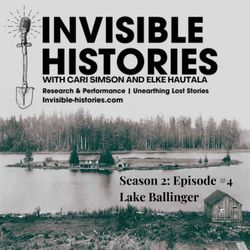
4. Lake Ballinger
43:06||Season 2, Ep. 4Since it’s a beautiful, warm summer day here in Seattle, this month’s episode features a short history of a beautiful lake with a mysterious island. You’ll find this lake on the southwestern corner of Snohomish County, on the edge of Edmonds and Mountlake Terrace, just north of Shoreline, Washington. Come with us to take a dip in the cool, refreshing waters of Lake Ballinger! Learn about the development of this area in the late 1800s through 1920s, with Hugh McAleer, the Bartholomew and Ballinger families, and the role of the Interurban Streetcar line on the Seattle suburbs in 1910, as it expanded from Greenwood in Seattle up to Everett, WA. We also dip a toe into the Alaska Yukon Pacific Exposition of 1909, and the rise of the progressive movement's land conservation efforts led by Gifford Pinchot. For Show Notes visit our WebpageWe are always looking for “invisible histories” of the Pacific NW so if you have a good story idea please reach out at invisiblehistoriespnw@gmail.comImage: Lake Ballinger from the Interurban line, Seattle ca. 1909, Asahel Curtis, courtesy of Paul Dorpat.Music:Lady of the Lake (1917) Victor Band and Emma Howells Burchenalhttps://archive.org/details/78_lady-of-the-lake_victor-band-emma-howells-burchenal_gbia0013588bSong of the West - Voices of America SeriesRecorded July 2024Audio edited by Elke Hautala